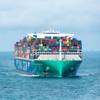Drewry’s latest quarterly Container Forecaster highlights that 2012 will be another challenging year for liner operators. With question marks over the strength of global demand, delivery of big ships will continue to be a problem and carriers’ future lay-up strategies will dictate if they make money or not.
London, UK, 4th January 2012 – Carriers will want to forget 2011 quickly. Based on 3Q11 financials and year-end industry dynamics, we forecast that the industry could lose as much as $5.2 billion, despite a projected global container growth of 6.5%. Overcapacity, poor headhaul growth on the major east-west routes and the continued fight for market share amongst the lead players ensured that spot rates eroded by more than 50% on the key headhaul routes by the end of 2011.
Even attempts by carriers to cull capacity during November and December did not act as a catalyst to lift rates by any meaningful margin. Spot rates have improved a little as of early January, but this is still likely to be a temporary phenomenon driven by the annual spike before Chinese New Year.
The biggest industry driver now is to place the largest ships in every major trade to ensure that carriers or alliances remain competitive on slot costs. This caused a major shift in the network configuration for the Asia-Europe trade whereby a number of carriers have clubbed together to share costs and ships and to provide shippers with an alternative to “Daily Maersk.” The service structures will be finalised by April 2012, although many carriers will continue to receive big ships throughout the rest of this year. With three major groupings in place, the remaining small players with sub 8,000 teu ships will find it extremely difficult to survive in this intense environment.
The global fleet above 8,000 teu will grow by 25% in 2012 and this will be a severe challenge for the industry to absorb, given that we foresee decent demand growth only in the emerging markets of Latin America, Indian Subcontinent, Africa and intra-Asia where sub-8,000 teu ships operate. Overall global demand growth for 2012 is forecasted at 5.4%
The current supply/demand fundamentals on the key east-west trades are not strong enough for carriers to push through any sustained revenue increases and we already know that some shipper contracts have been signed on the Asia-Europe trade this year for around $1,100 per 40ft all in – levels that are below break-even.
Neil Dekker, Drewry’s head of container research, stated, “We believe that at the current burn rate, carriers’ cash reserves will run out during the second half of 2012. If they do not put a substantial amount of tonnage into lay-up by this time, the consequences could be dire.”
At the moment, relatively few vessels from suspended services are being laid up or idled, with most being re-chartered or absorbed into other routes. However, we estimate that idling could reach as much as 8% of the global fleet during 2H12 – equal to about 1.3 – 1.4 million teu.
“Carriers will at some stage in 2012 be forced to idle tonnage, even if the lead players are showing no inclination to do so at the moment. This will enable a partial recovery in spot rates during the second half of this year. In the meantime, the industry will continue to change its structure as all stakeholders adapt to the difficult conditions. We still do not foresee any company acquisitions, as was the case in 2009 and consolidation is more likely to happen through the disappearance of small players.”













